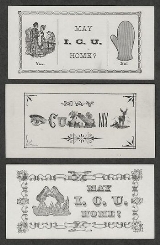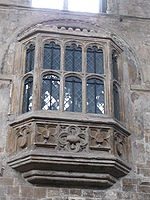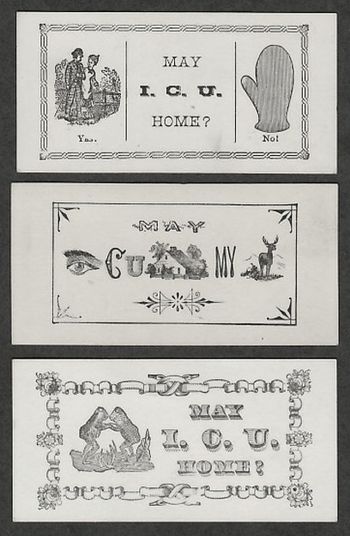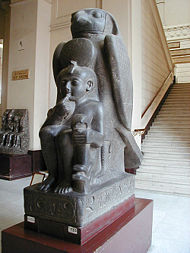
Rebus
Encyclopedia

Heraldry
Heraldry is the profession, study, or art of creating, granting, and blazoning arms and ruling on questions of rank or protocol, as exercised by an officer of arms. Heraldry comes from Anglo-Norman herald, from the Germanic compound harja-waldaz, "army commander"...
expression used in the Middle Ages
Middle Ages
The Middle Ages is a periodization of European history from the 5th century to the 15th century. The Middle Ages follows the fall of the Western Roman Empire in 476 and precedes the Early Modern Era. It is the middle period of a three-period division of Western history: Classic, Medieval and Modern...
to denote surnames, for example in its basic form 3 salmon fish to denote the name "Salmon". A more sophisticated example was the rebus of Bishop Walter Lyhart
Walter Hart
Walter Hart was a medieval Bishop of Norwich.He was nominated 24 January 1446 and was consecrated on 27 February 1446. He died on 24 May 1472.-References:...
(d.1472) of Norwich, consisting of a stag
STAG
STAG: A Test of Love is a reality TV show hosted by Tommy Habeeb. Each episode profiles an engaged couple a week or two before their wedding. The cameras then follow the groom on his bachelor party...
(or hart
Deer
Deer are the ruminant mammals forming the family Cervidae. Species in the Cervidae family include white-tailed deer, elk, moose, red deer, reindeer, fallow deer, roe deer and chital. Male deer of all species and female reindeer grow and shed new antlers each year...
) lying down in a conventional representation of water. The composition alludes to the name, profession or personal characteristics of the bearer, and speaks to the beholder Non verbis, sed rebus, which Latin expression signifies "not by words but by things" (res, rei (f), a thing, object, matter; rebus being ablative plural).
Rebuses and heraldry
Rebuses are used extensively as a form of heraldic expression as a hint to the name of the bearer; they are not synonymous with canting armsCanting arms
Canting arms are heraldic bearings that represent the bearer's name in a visual pun or rebus. The term cant came into the English language from Anglo-Norman cant, meaning song or singing, from Latin cantāre, and English cognates include canticle, chant, accent, incantation and recant.Canting arms –...
. A man might have a rebus as a personal identification device entirely separate from his armorials, canting or otherwise. For example, Sir Richard Weston
Richard Weston
Richard Weston was an English botanist.Weston was originally a thread-hosier of Leicester, but in some of his anonymous works describes himself as "a country gentleman". In 1773 he was living at Kensington Gore, but later was living at Leicester where he was secretary of the local agricultural...
(d.1541) bore as arms: Ermine, on a chief azure five bezant
Bezant
Bezant is a medieval term for a gold coin from the Byzantine Empire, which term is derived from the Greek name Βυζάντιον for the relatively minor city which in the 4th c. became the capital of the Eastern Roman Empire, renamed Constantinople by the Roman Emperor Constantine the Great...
s, whilst his rebus, displayed many times in terracotta plaques on the walls of his mansion Sutton Place, Surrey
Sutton Place, Surrey
Sutton Place, 3 miles NE of Guildford in Surrey is a Grade I listed Tudor manor house built c.1525 by Sir Richard Weston, courtier of Henry VIII. It is of great importance to art history in showing some of the earliest traces of Italianate renaissance design elements in English architecture. In...
, was a "tun" or barrel, used to designate the last syllable of his surname. An example of canting arms
Canting arms
Canting arms are heraldic bearings that represent the bearer's name in a visual pun or rebus. The term cant came into the English language from Anglo-Norman cant, meaning song or singing, from Latin cantāre, and English cognates include canticle, chant, accent, incantation and recant.Canting arms –...
proper are those of the Borough of Congleton
Congleton
Congleton is a town and civil parish in the unitary authority of Cheshire East and the ceremonial county of Cheshire, England, on the banks of the River Dane, to the west of the Macclesfield Canal and 21 miles south of Manchester. It has a population of 25,750.-History:The first settlements in...
in Cheshire consisting of a conger
Conger
Conger is a genus of marine congrid eels. It includes some of the largest types of eels, ranging up to 3 m in length, in the case of the European conger...
eel
Eel
Eels are an order of fish, which consists of four suborders, 20 families, 111 genera and approximately 800 species. Most eels are predators...
, a lion
Lion
The lion is one of the four big cats in the genus Panthera, and a member of the family Felidae. With some males exceeding 250 kg in weight, it is the second-largest living cat after the tiger...
(in Latin, leo) and a tun (another word for a barrel). This word sequence "conger-leo-tun" enunciates the town's name.
Similarly, the coat of arms of St. Ignatius Loyola contains wolves (in Spanish, lobo) and a kettle (olla), which is believed to be a rebus for "Loyola".
Modern word play
A modern example of the rebus used as a form of word playWord play
Word play or wordplay is a literary technique in which the words that are used become the main subject of the work, primarily for the purpose of intended effect or amusement...
is:
- H + = Hear, or Here.

By extension, it also uses the positioning of words or parts of words in relation to each other to convey a hidden meaning, for example:
- p walk ark: walk in the park
Pictograms

Pictogram
A pictograph, also called pictogram or pictogramme is an ideogram that conveys its meaning through its pictorial resemblance to a physical object. Pictographs are often used in writing and graphic systems in which the characters are to considerable extent pictorial in appearance.Pictography is a...
to represent a syllabic
Syllable
A syllable is a unit of organization for a sequence of speech sounds. For example, the word water is composed of two syllables: wa and ter. A syllable is typically made up of a syllable nucleus with optional initial and final margins .Syllables are often considered the phonological "building...
sound. This adapts pictograms into phonograms. A precursor to the development of the alphabet
Alphabet
An alphabet is a standard set of letters—basic written symbols or graphemes—each of which represents a phoneme in a spoken language, either as it exists now or as it was in the past. There are other systems, such as logographies, in which each character represents a word, morpheme, or semantic...
, this process represents one of the most important developments of writing
Writing
Writing is the representation of language in a textual medium through the use of a set of signs or symbols . It is distinguished from illustration, such as cave drawing and painting, and non-symbolic preservation of language via non-textual media, such as magnetic tape audio.Writing most likely...
. Fully developed hieroglyphs read in rebus fashion were in use at Abydos in Egypt as early as 3400 BCE.
The writing of correspondence in rebus form became popular in the 18th century and continued into the 19th century. Lewis Carroll
Lewis Carroll
Charles Lutwidge Dodgson , better known by the pseudonym Lewis Carroll , was an English author, mathematician, logician, Anglican deacon and photographer. His most famous writings are Alice's Adventures in Wonderland and its sequel Through the Looking-Glass, as well as the poems "The Hunting of the...
wrote the children he befriended picture-puzzle rebus letters, nonsense
Nonsense
Nonsense is a communication, via speech, writing, or any other symbolic system, that lacks any coherent meaning. Sometimes in ordinary usage, nonsense is synonymous with absurdity or the ridiculous...
letters, and looking-glass
Mirror
A mirror is an object that reflects light or sound in a way that preserves much of its original quality prior to its contact with the mirror. Some mirrors also filter out some wavelengths, while preserving other wavelengths in the reflection...
letters, which had to be held in front of a mirror to be read. Rebus letters served either as a sort of code
Code
A code is a rule for converting a piece of information into another form or representation , not necessarily of the same type....
or simply as a pastime.
The rebus principle

Linguistics
Linguistics is the scientific study of human language. Linguistics can be broadly broken into three categories or subfields of study: language form, language meaning, and language in context....
, the rebus principle means using existing symbols, such as pictograms, purely for their sounds regardless of their meaning, to represent new words. Many ancient writing systems used the rebus principle to represent abstract words, which otherwise would be hard to be represented by pictograms. An example that illustrates the Rebus principle is the representation of the sentence “I can see you” by using the pictographs of “eye—can—sea—ewe.” Some linguists believe that the Chinese developed their writing system according to the rebus principle, and Egyptian hieroglyphs sometimes used a similar system. A famous rebus statue of Ramses II uses three hieroglyphs to compose his name: Horus
Horus
Horus is one of the oldest and most significant deities in the Ancient Egyptian religion, who was worshipped from at least the late Predynastic period through to Greco-Roman times. Different forms of Horus are recorded in history and these are treated as distinct gods by Egyptologists...
(as Ra
Ra
Ra is the ancient Egyptian sun god. By the Fifth Dynasty he had become a major deity in ancient Egyptian religion, identified primarily with the mid-day sun...
), for Ra; the child, mes; and the sedge plant (stalk held in left hand), su; the name Ra-mes-su is then formed.
Rebuses and game shows
Rebuses were central to the United States television game showGame show
A game show is a type of radio or television program in which members of the public, television personalities or celebrities, sometimes as part of a team, play a game which involves answering questions or solving puzzles usually for money and/or prizes...
Concentration
Concentration (game show)
Concentration was an American TV game show based on the children's memory game of the same name. Matching cards represented prizes that contestants could win...
. Contestant
Contestant
A contestant is someone who takes part in a competition, usually a professional competition or a game show on television. The participants competing against each other have to go through rounds...
s had to solve a rebus, usually partially concealed, to win a game.
Lone Star Beer has rebus puzzles under the crown caps
Crown Cork
The crown cork , the first form of bottle cap, was invented by William Painter in 1891 in Baltimore. The company making it was originally called the Bottle Seal Company, but it changed its name with the almost immediate success of the crown cork to the Crown Cork and Seal Company...
of its bottled beer, as do National Bohemian
National Bohemian
National Bohemian Beer, colloquially called Natty Boh, National Boh or just plain Boh, is an American beer originally brewed in Baltimore, Maryland, but now brewed by the Miller Brewing Company in Eden, North Carolina, and distributed by the Pabst Brewing Company...
, Lucky Lager
Lucky Lager
Lucky Lager is a beer that has a strong cult following on Vancouver Island. At one time Lucky was actually brewed on Vancouver Island in Victoria but in 1982 Labatt Breweries of Canada moved off the Island and proceeded to tear down the brewery to prevent any competition on the Island...
, Falstaff, Olympia, Rainier, Haffenreffer
Haffenreffer Brewery
The Haffenreffer Brewery, established in 1870, was a former brewer in Jamaica Plain, Massachusetts. Haffenreffer Private Stock, a legacy of the original Heffenreffer & Co. product line, is a brand of malt liquor still manufactured by the Miller Brewing Company today.The entire Haffenreffer complex...
, Kassel
Kassel
Kassel is a town located on the Fulda River in northern Hesse, Germany. It is the administrative seat of the Kassel Regierungsbezirk and the Kreis of the same name and has approximately 195,000 inhabitants.- History :...
, Pearl
Pearl Brewing Company
The Pearl Brewing Company was an American brewery, established in 1883 in San Antonio, Texas. In 1985, Pearl's parent company purchased the Pabst Brewing Company and assumed the Pabst name...
, Regal, Ballantine, Mickey's
Mickey's
Mickey's is a malt liquor made by the Miller Brewing Company. It has an alcohol content of 5.8% by volume.Mickey's is widely known for its unique beehive-shaped, wide-mouthed 12 ounce bottle, often called a "grenade" due to its circular waffle design. The original packaging included Irish...
, Lionshead, Narragansett, and Texas Pride during the 1970's and the 1980's. These puzzle caps are also called "crown ticklers".
The United Kingdom
United Kingdom
The United Kingdom of Great Britain and Northern IrelandIn the United Kingdom and Dependencies, other languages have been officially recognised as legitimate autochthonous languages under the European Charter for Regional or Minority Languages...
also had a game show which required contestants to decipher a rebus. The show, Catchphrase
Catchphrase (game show)
Catchphrase is a British game show based on a short-lived US game show of the same name. It ran on ITV in the United Kingdom between 12 January 1986 and 19 December 2002, originally hosted by Northern Irish comedian Roy Walker....
, was a longstanding Saturday evening show, with Roy Walker
Roy Walker
Robert "Roy" Walker is a television personality and comedian from Northern Ireland, who worked for many years as both a television presenter and comedy actor...
as its most notable host. The Australian version of the show was hosted by John Burgess.
In 1998, Granada TV produced ‘Waffle,’ a single word rebus puzzle show that was hosted by Nick Weir, and included
premium telephone line viewer participation.
Low production values reduced the initial 2 million viewers of the ‘graveyard slot’ to zero within one series.
In Canada
Canada
Canada is a North American country consisting of ten provinces and three territories. Located in the northern part of the continent, it extends from the Atlantic Ocean in the east to the Pacific Ocean in the west, and northward into the Arctic Ocean...
, the 1980s
1980s
File:1980s decade montage.png|thumb|400px|From left, clockwise: The first Space Shuttle, Columbia, lifted off in 1981; American President Ronald Reagan and Soviet leader Mikhail Gorbachev eased tensions between the two superpowers, leading to the end of the Cold War; The Fall of the Berlin Wall in...
children's game show Kidstreet
Kidstreet
Kidstreet was a Canadian children's game show that aired from 1988 to 1992 and was hosted by Kevin Frank, with Kathy Morse as the announcer .Kidstreet was produced by Blair...
featured a rebus
during the bonus round (or "final lap").
Historic examples
- It is reported that when VoltaireVoltaireFrançois-Marie Arouet , better known by the pen name Voltaire , was a French Enlightenment writer, historian and philosopher famous for his wit and for his advocacy of civil liberties, including freedom of religion, free trade and separation of church and state...
was the guest of Frederick the Great at Sanssouci Palace, they exchanged puzzle notes. Frederick sent over a page with two picture blocks on it: two hands below the letter P, and then the number 100 below a picture of a handsaw, all followed by a question mark. Voltaire replied with: Ga!
- Both messages were rebuses in the French languageFrench languageFrench is a Romance language spoken as a first language in France, the Romandy region in Switzerland, Wallonia and Brussels in Belgium, Monaco, the regions of Quebec and Acadia in Canada, and by various communities elsewhere. Second-language speakers of French are distributed throughout many parts...
: deux mains sous Pé, cent sous scie? (= demain souper, Sanssouci? "supper tomorrow, Sanssouci?"); reply: "big G, small a!" Gé grand, A petit! (= j'ai grand appétit! "I am very hungry!").
- The early 16th century Bishop of ExeterBishop of ExeterThe Bishop of Exeter is the Ordinary of the Church of England Diocese of Exeter in the Province of Canterbury. The incumbent usually signs his name as Exon or incorporates this in his signature....
, Hugh OldhamHugh OldhamHugh Oldham was a Bishop of Exeter and a notable patron of education. Born in Lancashire to a family of minor gentry, he probably attended both Oxford and Cambridge universities, following which he was a clerk at Durham, then a rector in Cornwall before being employed by Lady Margaret Beaufort ,...
adopted the owl as his personal device. It bore a scroll in its beak bearing the letters D.O.M., forming a rebus based on his surname, which would probably have been pronounced at the time as owl-dom.
- The 19th century French sculptor Jean-Pierre DantanJean-Pierre DantanJean-Pierre Dantan Paris 1800 - Baden-Baden 1869 was a French portrait sculptor. His subjects include include many famous figures from the realms of politics , music and the arts , and literature...
would place rebuses on the soclesSocleSocle may refer to:* Socle * Socle...
of his caricature busts to identify the subject. For example, Victor HugoVictor HugoVictor-Marie Hugo was a Frenchpoet, playwright, novelist, essayist, visual artist, statesman, human rights activist and exponent of the Romantic movement in France....
was an axe (hache in French, which sounds like the French pronunciation of "H") + UG + crossed bones (os, sounding like "O"). Hector BerliozHector BerliozHector Berlioz was a French Romantic composer, best known for his compositions Symphonie fantastique and Grande messe des morts . Berlioz made significant contributions to the modern orchestra with his Treatise on Instrumentation. He specified huge orchestral forces for some of his works; as a...
was represented by the letters BER low on the socle, with a bed (lit, for "li") comparatively high on the socle (to mean "haut", the French for high, pronounced with a silent "h" and "t" and so sounding like "O").
- In the U.S., a rebus was used on the Continental CongressContinental CongressThe Continental Congress was a convention of delegates called together from the Thirteen Colonies that became the governing body of the United States during the American Revolution....
patterns minted in 1776 and later on the Fugio CentFugio CentOn April 21, 1787, the Continental Congress of the United States authorized a design for an official penny, later referred to as the Fugio cent because of its image of the sun shining down on a sundial with the caption, "Fugio"...
, the first federal coin, minted in 1787. According to Walter Breen, Elisha Gaullaudet engraved the dies, using sketches of Benjamin Franklin. The obverse depicts a sundial with the terms "Fugio" and "Mind Your Business". Fugio means "I flee", the sundial means time, and "mind your business" means "do your work". Therefore this rebus read, "Time flees, so do your work."
External links
- Lashon.net has Rebus puzzles in Hebrew.
- an example of using chinese-like characters to write English.
- The online music review La Folia offers rebuses derived from composers' names

